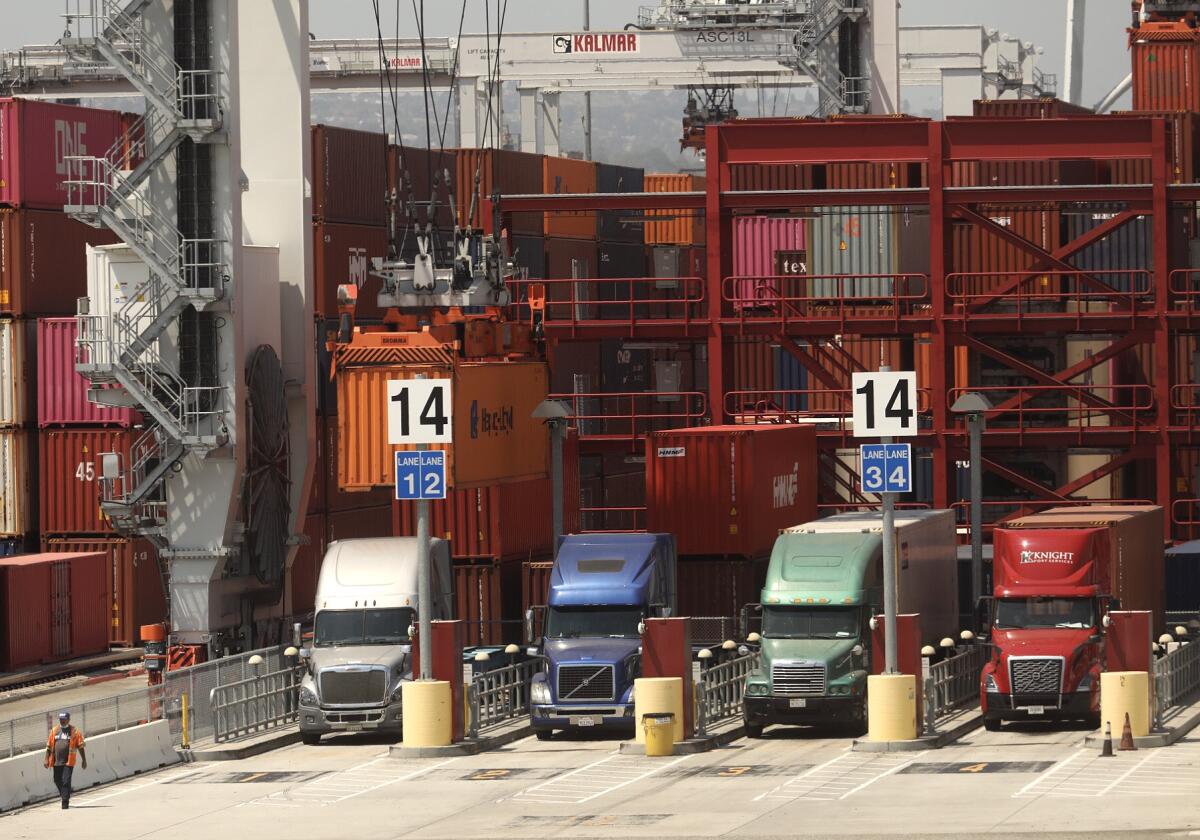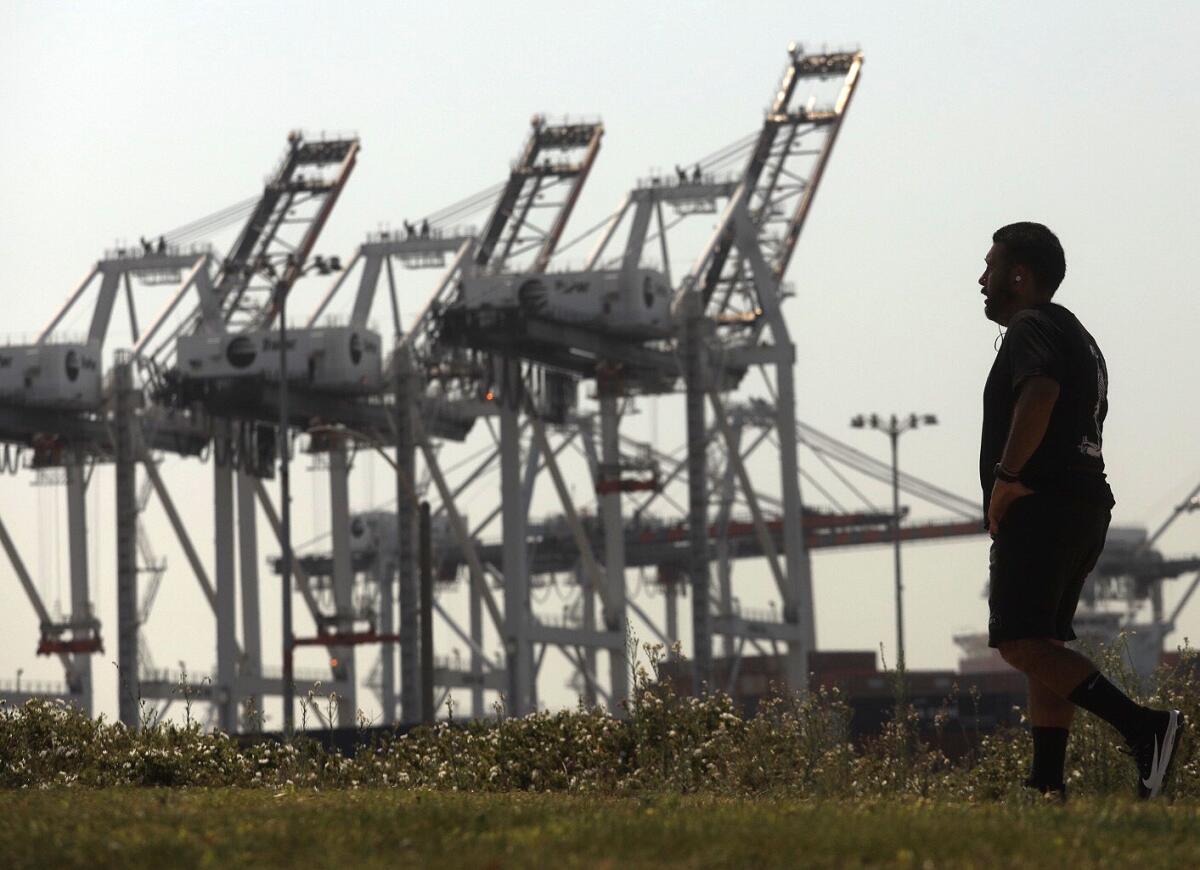California adopts major pollution cuts for diesel trucks and ships

California air quality officials have adopted their biggest pollution-cutting regulations in more than a decade, targeting diesel trucks and cargo ships that spew much of the state’s health-damaging pollution.
The pair of rules approved Thursday by the state Air Resources Board will be crucial in reducing smog and cancer risk to millions of Californians who, despite years of gradual improvement, still breathe the nation’s worst-polluted air. One establishes stringent new emissions standards for heavy-duty diesel trucks, and the other requires more ships docked at ports to plug into electric power or scrub their exhaust.
The measures are part of a multiyear push to clean up freight-moving industries that are both a lifeblood of California’s economy and its dominant source of harmful pollution. Diesel trucks emit nearly one-third of smog-forming nitrogen oxides and more than one-quarter of diesel particulate matter in the state. Oceangoing ships are projected to surpass trucks to become Southern California’s largest source of nitrogen oxides by 2023.
“We’re going after the two big polluters within port complexes and goods movement across the state,” Air Resources Board member Hector De La Torre said..
The truck standards face significant opposition from engine manufacturers and truckers, while ports and labor unions have sought to delay the ship pollution reduction measures, citing the COVID-19 pandemic. But the measures can’t come soon enough for people living near ports, warehouses and other freight-clogged areas, largely lower-income communities of color that have long suffered disproportionately from dirty air and higher rates of cancer and asthma.
Bill Magavern, policy director for the Coalition for Clean Air, said it was the 16-member panel’s “biggest day in over a decade for reducing the toxic diesel exhaust that is choking our communities.”
Tougher truck rules could, however, add to California’s many legal battles with the Trump administration. Much like the fight over auto emissions, California’s move to adopt its own stricter rules for heavy-duty trucks puts the state at odds with federal officials and manufacturers, who want a single, nationwide standard.
But the measures are crucial for Southern California, which has little hope of meeting looming deadlines to clean its smog to federal health standards without swift and dramatic cuts in truck and ship emissions.

South Coast Air Quality Management District Executive Officer Wayne Nastri, who oversees the four-county region of Southern California with the nation’s worst smog, called the truck emissions rule “a necessary but insufficient measure to achieve healthful air quality for the 17 million California residents living in the South Coast Basin.”
Also eager for tougher action are people living in communities such as San Bernardino, who have long paid with their health for environmental regulators’ failure to clean smog to federal standards. San Bernardino has experienced a boom in warehouse logistic centers that attract diesel trucks to an area with some of the nation’s highest levels of ozone, the invisible gas in smog that inflames the lungs and triggers asthma and other respiratory problems.
Alejandra Dávila, a 23-year-old education liaison, grew up in San Bernardino from age 7. But she didn’t understand how bad the smog really was until she went away for college in Massachusetts and breathed the clean air there.
Dávila has watched her mother, a high school Spanish teacher, suffer from asthma that has gotten worse over the years. “It didn’t even dawn on me until recently that maybe the reason that she’s having such a hard time breathing is because we are in San Bernardino, there are so many trucks coming in and out, and there’s no oversight on the air quality.”
Dávila welcomes tougher emissions rules as a step in the right direction, “but I wish something could be done to directly improve the air quality in the next year and mitigate the harm that has already been done” she said. “Every day that we wait is a day that somebody’s asthma gets worse.”
The new standards would reduce allowable emissions of nitrogen oxides from new trucks 90% by 2027.
The rule, which has been in development for more than seven years, is the state’s biggest cut in smog-forming pollutants since 2008 and is equivalent to taking 16 million cars off the road, according to the air board. That’s nearly two-thirds of 26 million light-duty vehicles currently operating in California.
Curbing those emissions will prevent about 3,900 early deaths and 3,150 hospitalizations, according to the air board, which valued health benefits of the standards at nearly $37 billion, far outweighing the $4.5 billion it will cost engine manufacturers to meet them. Much of the costs will be passed on to customers, increasing the price of a truck in California by up to 6%.
Vehicle and engine manufacturers have fought the new standards to avoid the headache of designing and producing vehicles for two sets of standards: one for California and other like-minded states that adopt its rules, and one for the rest of the country.
The Truck and Engine Manufacturers Assn. submitted more than 300 pages of comments opposing the measures as an “extremely aggressive California-only regulatory program,” with provisions so onerous and costly they would force some producers to leave the California market. The Chicago-based trade association said the COVID-19 pandemic has crippled the industry’s research and development and its capabilities to develop less-polluting products.
”California-only standards will achieve less emission reduction in California than a national approach while also hurting the competitiveness of California-based truckers,” said Chris Shimoda, vice president of government affairs for the California Trucking Assn.
The U.S. Environmental Protection Agency announced in 2018 that it would pursue new nationwide emissions standards to clean nitrogen oxide emissions from trucks, but has lagged behind schedule and is not expected to unveil its proposal until after the November election.
“The EPA continues to work on the Cleaner Trucks Initiative,” EPA spokeswoman Enesta Jones said in an email Wednesday. “As with any large regulatory effort, schedules get adjusted on a regular basis,” she said, but she did not have a comment on California’s proposed rules.
California air board officials said they have worked with the EPA and negotiated for years with manufacturers but could not justify further delay because of the severity of California’s air pollution and the uncertainty over whether the Trump administration would act.
The rules adopted Thursday would also overhaul emissions-testing procedures to better account for real-world driving, including when trucks are idling, traveling slowly or in stop-and-go traffic and are known to release much higher levels of pollution.
The new diesel emissions standards are intended to work in concert with a pioneering sales mandate the air board adopted in June requiring manufacturers to transition to zero-emission electric or fuel cell models until every new truck sold in the state is zero-emission by 2045.
“Diesel emissions are bad for health and we’ve got to get rid of diesel,” said Dr. John Balmes, a professor of medicine at UC San Francisco who sits on the Air Resources Board. “But since we still need to have some diesel vehicles for the short term, they have to be as clean as possible.”
The ship pollution measures approved by the board will expand state regulations to increase the number of ships that, while docked in port, must either shut down their auxiliary engines and plug into shore-based electricity or connect to machines that clean their exhaust. Over time, more types of vessels, including oil tankers and ships that transport vehicles, would be subject to the rules.
A health analysis last year by air board staff found the new rules would reduce cancer risk for about 2.4 million residents living around the ports of Los Angeles and Long Beach.
The Air Resources Board had planned to bring the measures for a final vote in the spring, and had accelerated the implementation schedule after criticism from community groups and environmentalists that health benefits would come too slowly. But officials backtracked after COVID-19 hit and brought calls from ports, dockworkers and the shipping industry to delay the rules, citing the pandemic. They also added provisions that would allow compliance by funding emissions reduction projects elsewhere, such as cleaner locomotives.
Still, dockworkers fear the rules will divert shipments to other ports with fewer environmental requirements.
“They’re going to turn around and say I’m going to Houston because there’s no standard there,” said Danny Miranda, president of International Longshore and Warehouse Union Local 94. That could come at the cost of good-paying jobs, he said, especially in unloading so-called roll-on/roll-off ships. They carry vehicles that must be driven off one by one, a labor-intensive process that can take more than 30 longshoremen eight hours to complete.
The implementation delays disappointed environmentalists, who want ship pollution reined in as quickly as possible to ease the health damage to hard-hit communities like Wilmington, West Long Beach and West Oakland.
Francis Yang, a Long Beach-based organizer with the Sierra Club’s My Generation campaign, said that “millions of lives have already been affected and even some are lost” from pollution by a goods movement hubs that “built their empires off the lungs of Black and brown communities. They’ve externalized all their costs off the health of people.”
Neither the truck nor ship rules will bring immediate air quality improvements because they do not start taking effect until 2023 or later and take years more to phase in.
“That’s more time that ships continue to pollute our air,” Yang said. “That’s more time for the same front-line communities to have to wait to breathe.”
More to Read
Sign up for Essential California
The most important California stories and recommendations in your inbox every morning.
You may occasionally receive promotional content from the Los Angeles Times.











